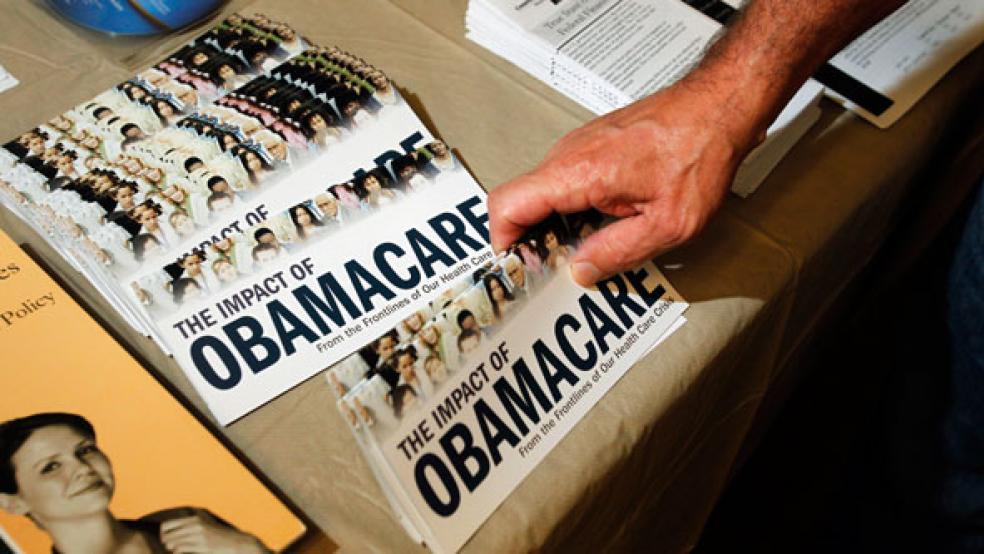Welcome to the Wonk Cycle of the Republican primary season. Voters traditionally do not engage heavily in presidential campaigns until after Labor Day at the earliest, so candidates keep their options open on policy and focus on expanding their name recognition and media attention. This cycle is no different.
Thus far, the candidates have mainly engaged in ideological sparring, with Donald Trump the undisputed leader in the early phase of the campaign. Trump hasn’t raised or spent much money relative to the other campaigns, but shrewdly keeps his name trending through constant media appearances, usually by phone, and blunt statements that become water-cooler currency for several news cycles.
Related: Replace Obamacare With What? GOP Candidates Start Slinging Proposals
Other Republicans have had a difficult time competing with Trump on media notoriety, so they have instead begun to focus on substantive policy statements. Even Trump has begun shifting his strategy toward policy, releasing an outline of his approach on immigration earlier this week – and dominating the headlines for another news cycle. This week, two more Republican candidates – Senator Marco Rubio and Governor Scott Walker – followed suit on a different topic, the repeal and replacement of the Affordable Care Act.
For five years, the repeal of Obamacare has been a litmus test for Republicans. Passion for its dismantling drove turnout in both the 2010 and 2014 elections, the latter especially after its disastrous rollout and the failure to live up to Barack Obama’s promises that it would not be disruptive for most Americans. Without controlling the White House, however, Republicans cannot fulfill that mandate, and the GOP loss in the 2012 presidential election allowed their best chance to easily deconstruct it pass through their fingers.
The Republican voter base has grown distrustful of the commitment from party leadership to repeal and replace Obamacare.
The Republican voter base has grown distrustful since then of the commitment from party leadership to repeal and replace Obamacare. Given those circumstances, it makes sense that the first policy issue addressed is healthcare reform. On the broad strokes, both Walker and Rubio follow the general parameters of Republican health-system reform plans offered over the last five years, and differ from each other in only minor ways. However, both miss the issue that allowed Democrats the political space to force Obamacare passage in the first place.
Rubio’s plan consists of a more conceptual three-pillar approach to reform rather than detailed policies. In fact, it’s not new; the plan published as an op-ed in Politico is nearly a copy of an op-ed published by Fox News in March . Walker’s plan is more detailed and breaks out into five conceptual areas, but covers much the same ground. They both propose, in one form or another, to do the following:
- Remove mandates in favor of tax incentives
- Allow much broader use of health-savings accounts (HSAs)
- Turn Medicaid into a block-grant system for states to control
- Allow interstate sales of health insurance policies
Related: Some Public Hospitals Win, Others Lose With Obamacare
There are other similarities, as well as a few differences, mainly from the lack of detail in Rubio’s proposal. One significant difference is tort reform, which Walker includes in his package, but he only promises to incentivize states to adopt tort reform rather than impose it from the federal level. Rubio includes the Paul Ryan concept of gradually shifting Medicare away from a single-payer system to a premium-support program that allows for patient choice, which would be important for deficit and debt control as well.
Both of these advance reform in a significantly different direction than Obamacare. NBC News called this “much different” than the ACA is, mainly because of rollbacks in federal direction of the health-care marketplaces. The end of the individual mandate will be very popular with Republicans and many others, if polling is correct.
These plans shift costs back to those who create them, alleviating the burden on young people whom the ACA forces into comprehensive policies they largely don’t need and will rarely access. Bill Kristol lauded them as “credible,” and Americans for Tax Reform called them “good for taxpayers.”
Still, these plans do not touch on the heart of what drove the healthcare reform debate in the first place: rising costs that outstripped earnings growth for middle-class households. Both the Walker and Rubio plans do little to eliminate the price-signal opacity that comes with comprehensive insurance and the market realities that are shielded from the end user except through premium hikes, which appear arbitrary when they appear.
Related: Will Health Insurer Mega-Mergers Cost Your More?
Both of them propose to return to an enhanced version of the status quo ante, but the lack of price signaling will create the same escalation of costs in their systems as well. That will eventually bring back demand for a centralized solution, and the next time it might just be single-payer.
Bobby Jindal blasted the Walker plan after its release on Tuesday, calling it “shocking that a Republican candidate for President would author a cradle to grave plan like this.” Jindal, whose own plan discusses the need to restore pricing signals but does not offer a specific path to that end other than online posting of prices, says that the Walker plan is another form of “dependence on government … a new federal entitlement program.”
That may be too harsh, but there is a kernel of truth in it for both the Walker and Rubio plans, and perhaps even for Jindal’s as well. There is much to like in all of them, but to an extent, these are incremental changes that accept the ubiquity of third-party payers for even routine care.
A true market reform would model itself on the efficient health-care markets where insurance does not apply: cosmetic surgery and Lasik-style vision correction. Without third-party payers and their cost burden and pricing opacity, providers can compete on price and quality openly, consumers get full pricing signals, and the market attracts more providers. Shortages do not occur because price-fixing mechanisms are absent.
That same model can apply to routine health care. If anything, the skyrocketing deductibles under Obamacare presented consumers with the worst of both worlds: expensive premiums for comprehensive care and mainly out-of-pocket costs for clinic visits. That gives Republicans a wide-open door to incentivize insurers to offer policies that indemnify against serious injuries, illnesses, and hospitalizations rather than manage every single aspect of health care, since most consumers on Obamacare plans are already paying retail prices without the benefit of competition and choice.
Related: Walker Proposes Health Tax Credits By Age, Not Income
Family practitioners will be relieved of the enormous burden of dealing with insurance companies and fixed reimbursements. That would encourage more doctors to enter the field and open their own businesses, a much-needed change over the shortage of such practitioners now. That will improve competition, consumer choice, and patient control of treatment. Insurers can absorb customers with pre-existing conditions more easily for major-event coverage instead of admitting them to a comprehensive health management system, as Obamacare forced them to do.
It may be that even after winning the presidency, the best a Republican could do would be the kind of incremental change envisioned in these plans. But at least for now, Republicans have an opportunity to offer a truly free-market reform that will actually lower costs for everyone and restore sanity to the health-care system.
That’s a vision worth proposing.






